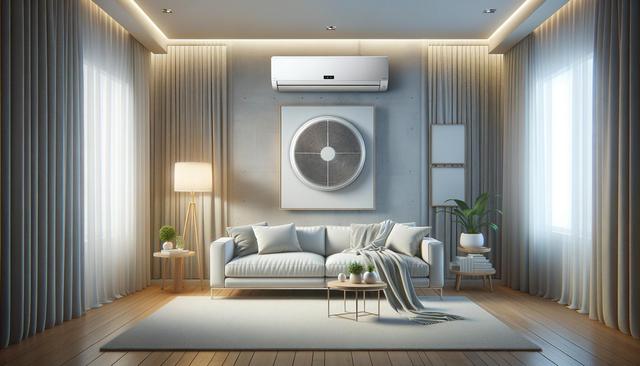What Is a Ductless Air Conditioner and How Does It Work?
A ductless air conditioner, also known as a mini-split system, is a modern cooling solution that operates without the need for extensive ductwork. Unlike traditional central HVAC systems, ductless AC units consist of an outdoor compressor and one or more indoor air-handling units. These components are connected by a small conduit that houses the power cable, refrigerant tubing, and a condensate drain. This setup allows for targeted cooling in specific areas of your home.
Ductless systems use inverter technology, which allows the compressor to adjust its speed based on the cooling demand. This leads to more consistent indoor temperatures and greater energy efficiency. Whether you’re cooling a single room or multiple zones, ductless air conditioners offer reliable performance with minimal disruption to your home’s structure.
In homes where ductwork is not already in place, installing a ductless system can be far less invasive and time-consuming. This makes them especially attractive for older properties, home additions, or rooms that need extra cooling support.
Benefits of Choosing a Ductless AC Unit
There are several compelling reasons to consider a ductless air conditioner for your home. These systems deliver comfort and control while lowering operational costs and improving energy efficiency. Here are some of the key benefits:
- Flexible installation: No need for ductwork means quicker and easier setup, ideal for retrofits or new spaces.
- Energy efficiency: By cooling only the spaces being used, ductless units reduce wasted energy.
- Quiet operation: Indoor units are designed to run quietly, making them suitable for bedrooms and offices.
- Compact design: Sleek indoor units blend with your interior while taking up minimal space.
- Zoned comfort: Individual control of different areas allows for customized settings and improved comfort.
By combining these advantages, ductless air conditioners help homeowners create a more comfortable and cost-effective living environment.
Energy Savings and Environmental Impact
One of the standout features of ductless AC systems is their potential to lower energy consumption. Traditional central systems often lose energy through leaks in ductwork—sometimes as much as 30%. Ductless units eliminate this issue entirely, allowing for more direct and efficient cooling.
The ability to create zones within your home also plays a critical role in energy savings. You can cool only the rooms in use rather than the entire house, which significantly reduces electricity usage. Advanced inverter technology enables the system to run at variable speeds, avoiding the energy spikes associated with starting and stopping the compressor repeatedly.
In addition to saving money on monthly utility bills, ductless air conditioners contribute to a lower carbon footprint. Many models use environmentally friendly refrigerants and are designed with energy-efficient components to meet or exceed energy standards.
Installation and Maintenance Made Simple
One of the most appealing aspects of ductless air conditioning is the ease of installation. In most cases, professional installation can be completed in a single day, depending on the number of indoor units and the complexity of the layout. The system only requires a small hole in the wall for the conduit, which minimizes structural changes to your home.
Maintenance is also straightforward. Regular tasks include cleaning the filters, checking refrigerant levels, and ensuring that the outdoor unit remains unobstructed. Since there are no ducts to clean or inspect, homeowners can avoid many of the maintenance concerns that come with central air systems. Additionally, many ductless systems come with built-in diagnostics that alert you to potential issues, simplifying troubleshooting and repair.
Because of the lower likelihood of air leaks and contamination, these systems also contribute to improved indoor air quality. This can be particularly beneficial for people with allergies or respiratory sensitivities.
When Is a Ductless System the Right Choice?
While ductless air conditioners offer numerous advantages, they may not be the solution for every situation. Understanding when to opt for a ductless setup can help you make a more informed decision. Here are some ideal scenarios for choosing a ductless AC unit:
- Older homes: Avoid costly ductwork installation by opting for a non-invasive, ductless system.
- Room additions: Perfect for garages, basements, or sunrooms that lack existing HVAC connections.
- Downsizing within the home: If you’re only using a portion of your home, ductless units provide efficient, localized cooling.
- Multi-family homes or rentals: Offer individual climate control for tenants without requiring major renovations.
Before making a final decision, it’s a good idea to consult with a qualified HVAC technician. A professional assessment will help determine the size, placement, and number of units needed for optimal performance and comfort.
Conclusion: Cool Comfort Made Simple
Ductless air conditioners provide a practical, energy-efficient way to enhance your home’s comfort without the hassle of traditional ductwork. With benefits like zoned cooling, streamlined installation, and cost-effective operation, these systems are gaining popularity among homeowners looking for smarter climate control solutions.
If you’re seeking a flexible and modern alternative to central air systems, a ductless AC unit might be a worthwhile investment. It offers tailored comfort, lower long-term energy costs, and minimal maintenance—making it a smart choice for many residential settings.






